A proposed $800 million facility in Santa Clara County will put recycled water on the tech boom's doorstep.
"San Jose Mayor Sam Liccardo, Santa Clara Mayor Jamie Matthews and other Silicon Valley leaders on Monday took big gulps of recycled water -- filtered, cleaned and disinfected sewage -- to show that it is safe and should be a growing part of Silicon Valley's drinking water future," reports Paul Rogers.
The occasion of the photo op was the unveiling of a proposal "for an $800 million expansion of recycled water in Santa Clara County over the next 10 years." Rogers adds: "Under the new proposal, San Jose and the Santa Clara Valley Water District are calling for expanding that use from 20,000 acre-feet a year now to about 55,000 acre-feet a year -- or 20 percent of the county's total water demand -- by 2025."
Formerly known as toilet to tap, water utilities in some parts of the state, like Orange County, have already implemented recycled drinking water capacity in California. Santa Clara County has been using recycled water since 1997 "for irrigating golf courses, landscaping and other nondrinking uses, such as in industrial cooling."
On another note of interest to planners knowledgeable in California state law, the press conference included an appeal by the mayors for the state to suspend environmental review under the California Environmental Quality Act for the purposes of speeding approval and construction of the water recycling facility.
The article includes more information about the political implications of the project and the possible CEQA exemption as well as a cost comparison between water from the San Francisco Bay Delta, desalination, and recycled water.
FULL STORY: San Jose, Santa Clara mayors drink recycled sewage to push expanding reclaimed water

Study: Maui’s Plan to Convert Vacation Rentals to Long-Term Housing Could Cause Nearly $1 Billion Economic Loss
The plan would reduce visitor accommodation by 25,% resulting in 1,900 jobs lost.

North Texas Transit Leaders Tout Benefits of TOD for Growing Region
At a summit focused on transit-oriented development, policymakers discussed how North Texas’ expanded light rail system can serve as a tool for economic growth.

Why Should We Subsidize Public Transportation?
Many public transit agencies face financial stress due to rising costs, declining fare revenue, and declining subsidies. Transit advocates must provide a strong business case for increasing public transit funding.

How to Make US Trains Faster
Changes to boarding platforms and a switch to electric trains could improve U.S. passenger rail service without the added cost of high-speed rail.

Columbia’s Revitalized ‘Loop’ Is a Hub for Local Entrepreneurs
A focus on small businesses is helping a commercial corridor in Columbia, Missouri thrive.

Invasive Insect Threatens Minnesota’s Ash Forests
The Emerald Ash Borer is a rapidly spreading invasive pest threatening Minnesota’s ash trees, and homeowners are encouraged to plant diverse replacement species, avoid moving ash firewood, and monitor for signs of infestation.
Urban Design for Planners 1: Software Tools
This six-course series explores essential urban design concepts using open source software and equips planners with the tools they need to participate fully in the urban design process.
Planning for Universal Design
Learn the tools for implementing Universal Design in planning regulations.
Ascent Environmental
Borough of Carlisle
Institute for Housing and Urban Development Studies (IHS)
City of Grandview
Harvard GSD Executive Education
Toledo-Lucas County Plan Commissions
Salt Lake City
NYU Wagner Graduate School of Public Service





























